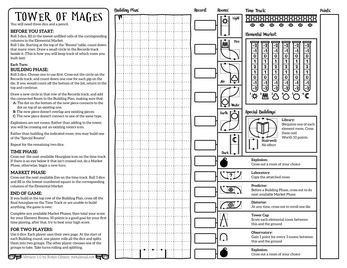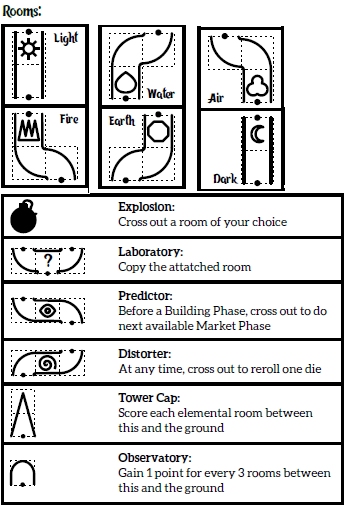Description
As long as there has been magic, there have been Mages’ Towers. Tall, dilapidated structures built in wild curves to tap into elemental energy. As the Solstice approaches, three Wizards break ground on what they’re sure will be… Well, it will be a tower anyway.
The cool thing about Tower of Mages is the unique tower designs that are created each time you play the game. No two games are ever the same, and this makes it highly replayable.
Every game starts with an empty grid that gets filled with laboratories, observation rooms, stairs and various elemental rooms. As the game progresses, you collect the energy from the elemental rooms as you try to predict and manipulate the elemental market.

By making strategic selections from three dice, you have a certain amount of control over what can be built.
As the value of elements rise and fall, you’ll want to concentrate on building higher value rooms. You will also want to try and cap towers at the ideal moment to maximize the value of their elemental energy (or points).
The entire game (and all the rules) are laid out on a single sheet of paper. You will need a sheet each time you want to play.
Because the rules are on a single page (and are very brief), some of the rules can lead to confusion. To get a good handle on the rules, watch the video included below and read through some of our play notes for clarification.
Game Phases
Each turn consists of a Building Phase, Time Phase, and Market Phase. Once all your towers are capped, or you have run off the edge of the board, the game is over.
In the building phase, you roll three dice. You can decide to use the dice in any order to select the best rooms from a rotating list. If you can’t draw a room (because of space limitations), you can opt for a simple stairwell instead.
A library is worth 10 points and can be built when you have the required prerequisites.
The fact you can decide the order that the dice are used introduces a good level of strategy to the game.

Once you have completed the building phase, you need to cross out one of the time symbols.

When you run out of time, the game is also over.
The reason you are building rooms is to collect elemental energy, and the value of elements change as the game progresses. The current value of each element is reflected in the market panel near the top of the game sheet.
The “Market” panel consists of 6 different elements (Light, Fire, Air, Water, Earth, Dark)

In the market phase of the game, you roll three dice, and cross off cells at the bottom of each gauge. This, in turn, increases or decreases the market price for the relevant elements.
Because the market values change on a random basis (and often with a predictable trend), the best strategy is to manipulate the dice to try and build rooms that have the highest valued elements – and to to cap the the towers off when the elements are near their highest values.
Strategic use of the explosion option allows you to remove low value rooms, and to replace them with higher valued elements.
Capping a tower early in the game allows you to lock in the market values of the elements directly below it, and to collect the points before the values start to fall again.
Play Notes
1) The explosions are not optional. If you end up selecting it, you have to play it by destroying a room somewhere on the board.
2) The market phase only occurs on every second turn. It happens when an eye appears under a time you are about to strike off. It can also be triggered by the “predictor” room.
3) If you cap a tower early, you can add up the value of the elements in the tower below your cap immediately. Cross the elements off as you do this, so they are not recounted at the end of the game.
4) The first die roll sets the starting position on the rotating list of rooms. You do not build the first room (or use the explosion icon) if you land on it.
5) The observatory counts all the rooms, including stairwells. It doesn’t care about symbols like the towers caps do.
6) The laboratory copies the element from the room you attach it to. (Ie the one directly below it). Simply copy the element icon from the room below into the observatory room.
7) If a room goes off the page, it can’t be drawn.
8) Explosions can’t be replaced with a stair case – but tower caps can!
9) When you build a library, you need to cross one of each element off of your tower diagram. The elements can be taken from anywhere on the board. The elements don’t need to be from the same tower.
10) The predictor allows you to start the next market phase at any time. In essence you are “seeing the future” (and adjusting the market). When you use the predictor, cross of the next available market icon (eye) below an unused time slot. You cannot use it if there are no unused market icons left.
